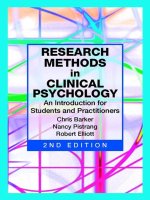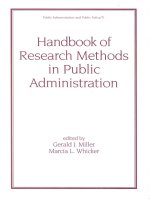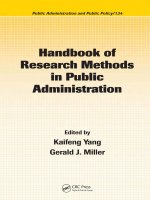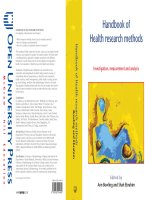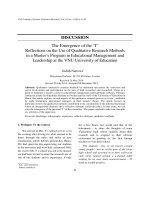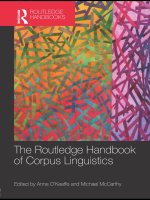The routledge handbook of research methods in the study of religion michael stausberg, steven engler, 2011 scan
Bạn đang xem bản rút gọn của tài liệu. Xem và tải ngay bản đầy đủ của tài liệu tại đây (6.49 MB, 569 trang )
ROUTLEDGE
HANDBOOKS
The Routledge Handbook
of Research Methods in the
Study of Religion
Edited by Michael Stausberg and Steven Engler
THE ROUTLEDGE HANDBOOK OF RESEARCH
METHODS IN THE STUDY OF RELIGION
This is the fi rst comprehensive survey in English of research methods in the field of religious
studies. It is designed to enable non-specialists and students at upper undergraduate and graduate levels to understand the variety of research methods used in the field. The aim is to create
awareness of the relevant methods currently available and to stimulate an active interest in
exploring unfamiliar methods, encouraging their use in research and enabling students and
scholars to evaluate academic work with reference to methodological issues. A distinguished
team of contributors cover a broad spectrum of topics, from research ethics, hermeneutics and
interviewing, to Internet research and video-analysis. Each chapter covers practical issues and
challenges, the theoretical basis of the respective method, and the way it has been used in
religious studies (illustrated by case studies).
Michael Stausberg is Professor of Religion at the University of Bergen, Norway. He is
author of Religion and Tourism: Crossroads, Destinations and Encounters, editor of Contemporary
Theories of Religion and European editor of the journal Religion.
Steven Engler is Associate Professor of Religious Studies at Mount Royal University,
Canada. He is a co-editor of Historicizing ‘Tradition’ in the Study of Religion and North American
editor of the journal Religion.
THE ROUTLEDGE HANDBOOK
OF RESEARCH METHODS IN
THE STUDY OF RELIGION
Edited by Michael Stausberg and Steven Engler
First published in 2011
by Routledge
2 Park Square, Milton Park, Abingdon, Oxon OX14 4RN
Simultaneously published in the USA and Canada
by Routledge
711 Third Avenue, New York, NY 10017
Routledge is an imprint of the Taylor & Francis Group, an informa business
© 2011 Michael Stausberg and Steven Engler for selection and
editorial matter; individual contributors, their contributions
The right of the editor to be identified as the author of the
editorial material, and of the authors for their individual
chapters, has been asserted in accordance with sections 77 and 78
of the Copyright, Designs and Patents Act 1988.
All rights reserved. No part of this book may be reprinted or reproduced or
utilised in any form or by any electronic, mechanical, or other means, now
known or hereafter invented, including photocopying and recording, or in
any information storage or retrieval system, without permission in writing
from the publishers.
Trademark notice : Product or corporate names may be trademarks
or registered trademarks, and are used only for identification and
explanation without intent to infringe.
British Library Cataloguing in Publication Data
A catalogue record for this book is available from the British Library
Library of Congress Cataloging in Publication Data
The Routledge handbook of research methods in the study of religion /
edited by Michael Stausberg and Steven Engler.
p. cm.
Includes bibliographical references and index.
1. Religion—Methodology. I. Stausberg, Michael. II. Engler, Steven.
III. Title: Handbook of research methods in the study of religion.
BL41.R686 2011
200.72—dc23
2011021788
ISBN: 978–0–415–55920–1 (hbk)
Typeset in Bembo
by Refi neCatch Limited, Bungay, Suffolk
CONTENTS
List of figures and plates
List of tables
List of boxes
List of contributors
Preface
viii
x
xi
xiii
xx
PART I
Methodology
1
1.1
Introduction: Research methods in the study of religion\s
Michael Stausberg and Steven Engler
3
1.2
Comparison
Michael Stausberg
21
1.3
Epistemology
Jeppe Sinding Jensen
40
1.4
Feminist methodologies
Mary Jo Neitz
54
1.5
Research design
Wade Clark Roof
68
1.6
Research ethics
Frederick Bird and Laurie Lamoureux Scholes
81
v
Contents
PART II
Methods
107
2.1
109
Content analysis
Chad Nelson and Robert H. Woods, Jr
2.2 Conversation analysis
Esa Lehtinen
122
2.3 Discourse analysis
Titus Hjelm
134
2.4 Document analysis
Grace Davie and David Wyatt
151
2.5 Experiments
Justin L. Barrett
161
2.6 Facet theory methods
Erik H. Cohen
178
2.7
204
Factor analysis
Kendal C. Boyd
2.8 Field research: Participant observation
Graham Harvey
217
2.9
245
Free-listing
Michael Stausberg
2.10 Grounded theory
Steven Engler
256
2.11 Hermeneutics
Ingvild Sælid Gilhus
275
2.12 History
Jörg Rüpke
285
2.13 Interviewing
Anna Davidsson Bremborg
310
2.14 Network analysis
jimi adams
323
vi
Contents
2.15 Phenomenology
James V. Spickard
333
2.16 Philology
Einar Thomassen
346
2.17 Semiotics
Robert A. Yelle
355
2.18 Structuralism
Seth D. Kunin
366
2.19 Structured observation
Michael Stausberg
382
2.20 Surveys and questionnaires
Juhem Navarro-Rivera and Barry A. Kosmin
395
2.21 Translation
Alan Williams
421
2.22 Videography
Hubert Knoblauch
433
PART III
Materials
445
3.1
447
Auditory materials
Rosalind I.J. Hackett
3.2 The Internet
Douglas E. Cowan
459
3.3 Material culture
Richard M. Carp
474
3.4
491
Spatial methods
Kim Knott
3.5 Visual culture
John Harvey
502
Index
523
vii
LIST OF FIGURES AND PLATES
Figures
1.6.1 Sample flowchart of the ethical review process
2.3.1 Macrostructure
2.5.1 Anatomy of an experiment
2.6.1 Sample mapping sentence 1
2.6.2 Sample mapping sentence 2
2.6.3 Correlation matrix for primary variables (input matrix for SSA)
2.6.4 SSA of symbols of Jewish identity without regionalization
2.6.5 SSA of symbols of Jewish identity, with preliminary regionalization
2.6.6 SSA map of symbols with center-periphery structure
2.6.7 Integrated SSA of symbols of Jewish identity
2.6.8 Correlation arrays for external variables
2.6.9 SSA of symbols of Jewish identity with sub-populations of
campers by camp affi liation as external variables
2.6.10 Representations of the profi les of the POSAC along two axes
(Torah study and freedom), without regionalization
2.6.11 Differentiating between profi les of campers who did and did
not select Torah study as a symbol of Jewish identity
2.6.12 POSAC differentiating between profi les of campers who did
and did not select freedom as a symbol of Jewish identity
2.6.13 Representations of the profi les of the POSAC along two axes
(Torah study and freedom), with regionalization
2.7.1 Scree plot of religious orientation eigenvalues, with line of
random variance
2.7.2 Religious orientation factors in varimax-rotated space
2.10.1 Grounded theory
2.10.2 Sample memo diagram
2.10.3 The data/theory spectrum
viii
101
137
164
181
186
188
189
190
191
191
193
194
196
196
196
196
210
212
257
261
265
Figures and Plates
2.11.1
2.14.1
2.14.2
2.18.1
2.18.2
2.18.3
2.22.1
2.22.2
3.2.1
3.2.2
3.4.1
3.5.1
Varieties of the hermeneutic circle
Exemplar graph
Two religious organizational networks
Israelite food rules
Levels of underlying structure
Ideal structural relations: negative, neutral and positive
The process of videographic analysis
Stills from video of a Marian apparition
The question matrix
Membership and message traffic
Spatial method: analytical steps
Religious studies and visual culture as gravitational
fields of study
3.5.2 Zones of external knowledge pertaining to artifacts
Plates
3.5.1 Protestant nonconformist banner (obverse)
3.5.2 Protestant nonconformist banner (back)
3.5.3 An example of unintentional visual blasphemy
3.5.4 Daveman, Jesus the Masochist, from the website of ‘The
Christian Holocaust’
ix
277
324
328
369
369
370
436
439
463
466
496
505
511
508
509
517
518
LIST OF TABLES
2.4.1
2.4.2
2.5.1
2.5.2
2.6.1
2.6.2
2.6.3
2.6.4
2.7.1
2.7.2
2.7.3
2.7.4
2.9.1
2.13.1
2.17.1
2.17.2
2.17.3
2.17.4
2.20.1
2.20.2
2.20.3
3.4.1
Questions to consider when using documents
Advantages and disadvantages of using unsolicited documents
Assessing experimental validity
Examples of experiments in the study of religion
Responses of participants in Jewish summer camps to symbols
of Jewish identity
Sample profi les
POSAC results along two axes
Mirror image profi les
Correlation matrix of religious orientation items
Eigenvalues for the religious orientation items
Religious orientation items factor structure
Religious coping promax factor loadings
Hypothetical item-by-item matrix
Sample coding of an interview
Types of sign (after Peirce)
Example 1: analysis of magic
Example 2: analysis of a folk charm
Example 4: analysis of Hindu tantric mantras
Sample size and margin of error according to population size
with a 95 per cent confidence
Datasets and existing surveys available online for analysis
Useful software and tools for designing and analyzing surveys
Mapping religions: case studies
x
153
158
171
173
186
194
195
199
208
209
210
213
252
318
357
358
358
360
401
415
417
494
LIST OF BOXES
1.2.1
1.2.2
1.2.3
1.2.4
1.2.5
1.2.6
1.2.7
1.2.8
1.4.1
1.4.2
1.4.3
1.5.1
1.6.1
1.6.2
1.6.3
1.6.4
1.6.5
1.6.6
1.6.7
1.6.8
1.6.9
2.1.1
2.1.2
2.1.3
2.1.4
Early advocates of comparison in religious studies
A comparative macro-study
An ideal-typical comparative study
A phenomenological comparison
Costs of and problems with comparative designs
Two examples of in-depth micro-studies
Checklist for comparative work
Purposes of comparative designs
Descriptive characteristics of standpoint methodology
Comparison across feminist methodologies
Maintaining a diverse discourse
Representational moments in fieldwork
Ethical concerns in research
Three general ethical principles of religious research
Respecting the dignity and integrity of others
Communicating honestly and objectively with our subjects
and audiences
Responsibly exercising judgement
Nuremberg Code (1947–49)
Belmont Report (USA, 1979)
Research ethics framework, Economic and Social Research
Council (ESRC) (UK, 2005)
Selected professional organizations that offer research ethics
protocols for research involving human subjects
Functions of content analysis
Units that can be counted in content analysis
Basic steps of content analysis
Advantages and limitations of content analysis
xi
23
25
27
28
29
30
31
34
55
56
60
77
83
84
88
90
92
95
96
97
98
111
113
114
117
Boxes
2.2.1
2.2.2
2.2.3
2.2.4
2.3.1
2.6.1
2.6.2
2.6.3
2.8.1
2.8.2
2.9.1
2.9.2
2.10.1
2.10.2
2.10.3
2.15.1
2.16.1
2.16.2
2.19.1
2.19.2
2.21.1
2.21.2
3.1.1
3.2.1
3.2.2
3.3.1
3.3.2
3.3.3
3.3.4
3.3.5
3.3.6
3.3.7
3.5.1
3.5.2
3.5.3
Extract 1: Mormon proselytizing
Extract 2: Seventh-day Adventist Bible study
Steps to take in conversation analytical research
Transcription symbols
The constructive effects of discourse
When is facet theory applicable for studies of religion?
Scope of facet theory
Steps in conducting a Smallest Space Analysis (SSA)
Stages in the fieldwork process
Key skills for fieldwork
A study of Zoroastrian priests
Additional variations and prompting techniques
An example of open coding
Sample memos
Elements of grounded theory method
Four steps in phenomenological method
An example of textual criticism
‘Manuscript’ and ‘text’
Typical stages and steps of structured observation
The observation protocol
Questions raised by translation
Some models of translation
Reasons for lack of research on sound production/perception
Questions to ask in Internet research
Assessing online participation
Religion and the history of technology
Systematic questioning as method
Body methods in the study of religion
Behavioral approach to k lam of South Asia
Cultural landscape and religion in Indianapolis
Lineage
A checklist for methods in religion and material culture
Graffiti as visual culture
Disciplinary analysis of a Protestant nonconformist banner
The Angel of the North (Antony Gormley, 1994–98)
xii
125
127
128
129
136
179
181
184
220
224
247
253
258
260
262
338
348
349
387
388
422
430
451
464
466
475
477
478
479
480
482
485
503
510
513
CONTRIBUTORS
jimi adams is Assistant Professor, School of Social and Family Dynamics, Arizona State
University, USA. His main areas of work are social networks and the diffusion of ideas/
diseases. His work has been published in Social Networks; Field Methods; Demographic Research
and the Handbook of Medical Sociology.
Justin L. Barrett is Thrive Chair of Applied Developmental Psychology and Professor of
Psychology at Fuller Theological Seminary, and Research Associate of the University of
Oxford’s Centre for Anthropology and Mind. He works in the areas of cognitive anthropology, cognitive science of religion, psychology of religion, and cognitive, religious and
character development. Main publications include Why Would Anyone Believe in God? (2004);
Cognitive Science, Religion, & Theology (2011) and Born Believers (2011). He is book review
editor of the Journal of Cognition & Culture, a consulting editor of Psychology of Religion &
Spirituality and an editorial board member of Religion, Brain, and Behavior.
Frederick Bird is Research Professor in the Department of Political Science at the University
of Waterloo in Ontario, Canada. He is also a Distinguished Professor Emeritus at Concordia
University in Montréal, Québec, Canada, where he was a professor in the Department of
Religion and held a Concordia University Research Chair in Comparative Ethics. His publications include Voices from the Voluntary Sector: perspectives on leadership challenges (co-edited with
Frances Westley, 2010); Just Business: practices in a diverse and developing world (co-edited
with Manuel Velasquez, 2006); International Business and the Dilemmas of Development (co-edited
with Emmanuel Raufflet and Joseph Smucker, 2005); International Businesses and the Challenges of
Poverty in the Developing World (co-edited with Stewart W. Herman, 2004); Ritual and Ethnic
Identity: a comparative study of liturgical ritual in synagogues (co-authored with Jack N. Lightstone et
al., 1996). For a number of years he chaired the university’s Human Research Ethics Committee.
Kendal C. Boyd is Associate Professor of Psychology at Loma Linda University, USA. His
research areas include medically unexplained symptoms, chronic pain, post-traumatic stress
disorder, sports fan dynamics, the psychology of religion, and statistics/methodology. In
addition to his dissertation being a Monte Carlo study on the number of factors criteria in
exploratory factor analysis, he has published factor analytic studies in the area of medically
xiii
Contributors
unexplained symptoms. He is a clinical psychologist who also holds an MA in Theology from
Fuller Theological Seminary. He recently authored a chapter in the edited volume A Christian
Worldview and Mental Health: Adventist perspectives.
Anna Davidsson Bremborg (PhD Lund University, Sweden), is a sociologist of religion.
Her main areas of research are death studies and pilgrimages. She has published two books:
Yrke: begravningsentreprenör [Occupation: funeral director] (2002) and Pilgrimsvandring på
svenska [Pilgrimages, the Swedish way] (2010). She has published articles in several edited
books and in journals such as the Journal of Empirical Theology, Mortality and Social Compass.
Richard M. Carp is Vice Provost for Undergraduate Academics at St. Mary’s College of
California. He works in the interstices of the academic study of religion, performance, semiotics, anthropology, and visual art and design, as well as theory and method of interdisciplinarity. He is the director and editor of The Image Bank for Teaching World Religion (1992). He
has published in various edited volumes and journals including Teaching Theology and Religion,
Issues in Integrative Studies and Historical Reflections/Réflèxions historiques. With Rebecca Sachs
Norris he is editor of Studies in Body and Religion: a series.
Erik H. Cohen is Associate Professor of Sociology at the School of Education, Bar Ilan
University, Israel. His main areas of work are Jewish identity, youth culture, tourism and
migration, and Facet Theory research methodology. He is the author of Youth Tourism to Israel:
educational experiences of the diaspora (2008). His work has been published in Religion, Current
Sociology and Annals of Tourism Research. He is the co-founder and editor of the International
Journal of Jewish Education Research.
Douglas E. Cowan is Professor of Religious Studies at Renison University College, the
University of Waterloo, in Ontario, Canada. His current areas of interest include religion and
fi lm, religion and popular culture, and religion and technology. His major publications
include Sacred Space: The Quest for Transcendence in Science Fiction Film and Television (2010);
Sacred Terror: religion and horror on the silver screen (2008); Cults and New Religions: a brief
history (with David G. Bromley, 2008), and Cyberhenge: modern Pagans on the Internet
(2005). He is formerly a co-general editor of Nova Religio: The Journal of Alternative and
Emergent Religions and is currently the New Religious Movements section editor for Religion
Compass.
Grace Davie is Professor emerita in the Sociology of Religion in the University of Exeter
(UK). Her work is principally concerned with the changing place of religion in European and
other societies, and the pressing need for new ways of working in the social sciences in order
to understand this. She is the author of Religion in Britain since 1945 (1994); Religion in Modern
Europe (2000); Europe: the exceptional case (2002); The Sociology of Religion (Sage 2007). She is
co-author of Religious America, Secular Europe (2008), and co-editor of Welfare and Religion in
21st Century Europe (2 vols; 2010 and 2011).
Steven Engler is Associate Professor of Religious Studies at Mount Royal University and
Affi liate Associate Professor of Religion at Concordia University, Canada. He works on religion in Brazil and theory of religion. He is co-editor (with Gregory Price Grieve) of
Historicizing ‘Tradition’ in the Study of Religion (2005). He is North American editor of the
journal Religion, co-edits the book series Studies in the History of Religions and edits the book
xiv
Contributors
series Key Thinkers in the Study of Religion. He has recent and forthcoming articles (some
co-authored with Mark Q. Gardiner) in Journal of Ritual Studies, Method & Theory in the Study
of Religion, Nova Religio: The Journal of Alternative and Emergent Religions, Numen, Religion,
Religious Studies, Revista de Estudos da Religião (Rever) and Studies in Religion\Sciences religieuses.
Ingvild Sælid Gilhus is Professor of Religion at the University of Bergen, Norway. She
works in the areas of religions in late antiquity and new religious movements. Main publications include Laughing Gods, Weeping Virgins: laughter in the history of religions (1997) and
Animals, Gods and Humans: changing attitudes to animals in Greek, Roman and early Christian ideas
(2006). She is book review editor of Numen and is editorial board member of Temenos.
Rosalind I.J. Hackett is Professor and Head of Religious Studies at the University of
Tennessee, Knoxville, USA. In 2010 she was re-elected President of the International
Association for the History of Religions (until 2015). She has published widely on religion in
Africa, notably on new religious movements, and religion and confl ict in Nigeria. Her most
recent books are (as editor) Proselytization Revisited: rights talk, free markets, and culture wars
(2008) and Displacing the State: religion and conflict in a neoliberal Africa (co-edited with James
H. Smith, 2011). She serves on numerous editorial boards, such as Religion, Method and Theory
in the Study of Religion, Culture and Religion and the Journal of Religion in Africa.
Graham Harvey is Reader in Religious Studies, The Open University, UK. His research
interests are primarily in the lived realities and performances of contemporary Paganisms and
indigenous religions, but he has also researched ancient Jewish textual issues. His edited
publications include Religions in Focus: new approaches to tradition and contemporary practices
(2009). He is the author of Listening People, Speaking Earth: contemporary Paganism (2nd edn
2006) and Animism: respecting the living world (2005). He is co-editor of the Vitality of Indigenous
Religions series.
John Harvey is Professor of Art and Director of the Centre for Studies in the Visual Culture
of Religion, The School of Art, Aberystwyth University, UK. He is an historian of art and
visual culture and a practitioner in visual and sonic fi ne art. His research field is the visual
culture of religion. He has written several books including Photography & Spirit (2007); The
Appearance of Evil: apparitions of spirits in Wales (2003); Image of the Invisible: the visualization
of religion in the Welsh Nonconformist tradition (1999); and The Art of Piety: the visual culture of
Welsh Nonconformity (1995). His art practice is represented in The Pictorial Bible (2000, 2007,
2011), and The Aural Bible (2011) series of exhibitions, performances and texts. He is a member
of the editorial board for the journal of Biblical Reception (2010).
Titus Hjelm is Lecturer in Finnish Society and Culture at University College London, UK.
His main areas of expertise are cultural sociology, sociology of religion, social problems,
social theory, media and popular culture. His research focuses on the role of minority religions in contemporary societies and the media treatment of alternative religion. He is editor
of Religion and Social Problems (2011) and co-editor of the Journal of Religion in Europe. He has
published several book in Finnish and articles in journals such as Social Compass and Journal of
Contemporary Religion.
Jeppe Sinding Jensen is Associate Professor in the Department for the Study of Religion,
Associated Researcher, at MINDlab, and co-ordinator in the research unit Religion,
xv
Contributors
Cognition and Culture, all at Aarhus University, Denmark. Current main areas of interest
include the philosophy of science for the study of religion and culture, post-analytic philosophy and semantics, theories of narrative and discourse, the relations between cognition and
culture, cultural and moral psychology, and method and theory in the study of religion.
Major book publications include: Rationality and the Study of Religion (ed. with Luther H.
Martin 2003), The Study of Religion in a New Key (2003), Myths and Mythologies: a reader
(2009). Forthcoming is Meaning – in religion, cognition and culture. He is an editorial board
member of Method & Theory in the Study of Religion and editor of the book series Religion,
Cognition, and Culture.
Hubert Knoblauch is professor of General Sociology at the Technical University of Berlin,
Germany. His main areas of work are the sociology of knowledge, communication and
religion. His books selected include Populäre Religion [Popular Religion] 2009; Visual Analysis:
new developments in the interpretative analysis of video and photography (co-edited with Alejandro
Baer, Eric Laurier, Sabine Petschke and Bernt Schnettler, a special issue of Forum Qualitative
Social Research 3 (2008)); Video Analysis: methodology and methods – qualitative audiovisual data
analysis in sociology (co-edited with Bernt Schnettler, Jürgen Raab and Hans-Georg Soeffner
2006; 2nd edn 2009); Qualitative Methoden der Religionsforschung [Qualitative Methods in
Religious Studies] 2003; Religionssoziologie [Sociology of Religion] 1999.
Kim Knott is Professor of Religious Studies at Lancaster University, UK, and until recently
was Director of a major UK research programme on ‘Diasporas, Migration and Identities’.
She works in the fields of religion, space and place, and religion and public life, and, with
Elizabeth Poole and Teemu Taira, is completing a book on Media Portrayals of Religion and the
Secular Sacred. Her books include Diasporas: concepts, intersections, identities (ed. with Seán
McLoughlin, 2010), The Location of Religion: a spatial analysis (2005), and Hinduism: a very short
introduction (2000). She is on the editorial boards of Religion, South Asian Diasporas and Journal
of Contemporary Religion.
Barry A. Kosmin is Research Professor in the Public Policy and Law Program at Trinity
College, USA, and Founding Director of the Institute for the Study of Secularism in Society
and Culture. He is a sociologist and has been a principal investigator of the American
Religious Identification Survey series since its inception in 1990 as well as national social
surveys in Europe, Africa and Asia. His publications include One Nation Under God: religion in
contemporary American society (1993) and Religion in a Free Market (2006). He is a former joint
editor of the journal Patterns of Prejudice.
Seth D. Kunin is Professor in the Anthropology of Religion and Pro-Vice-Chancellor (Arts
and Humanities) at Durham University, UK. His main areas of work are Neo-Structuralism,
identity, crypto-Judaism (particularly in New Mexico) and biblical and rabbinic myth and
ritual. His main publications include Juggling Identities (2010), We Think What We Eat (2004),
Religion: the modern theories (2003) and The Logic of Incest (1995). His work has been published
in journals such as Religion, Temenos and Journal for the Study of the Old Testament.
Esa Lehtinen is Professor of Modern Finnish at the University of Vaasa, Finland. He has
conducted research on spoken interaction in religious, medical and organizational settings.
He has published in various journals, e.g. Journal of Pragmatics, Human Studies, Religion, Sociology
of Health & Illness and Text.
xvi
Contributors
Juhem Navarro-Rivera is a Research Fellow at the Institute for the Study of Secularism in
Society and Culture in Trinity College and adjunct professor of Latino Studies at the Puerto
Rican and Latino Studies Institute at the University of Connecticut, USA. A political scientist, he has worked on surveys and designed questionnaires for research in Puerto Rico and
the USA on political behavior, public health and religious identification. His publications
include chapters in New Drugs on the Street: changing patterns of illicit consumption (2005) and
Secularism and Science in the 21st Century (2008) and articles in the Journal of Ethnicity in Substance
Abuse and Human Organization. He is the main analyst of the 2008 American Religious
Identification Survey.
Mary Jo Neitz is Professor of Women’s and Gender Studies at the University of Missouri,
USA. She is a sociologist of religion and culture with interests in methodology, gender and
sexuality. She is interested in changing religious practices of ordinary people in relation to
religious institutions and the dynamics of global changes. She is the author of Sociology on
Culture (with John Hall and Marshall Battani, 2003); Culture: Sociological Perspectives (with
John Hall, 1993; Chinese edition, 2002); Charisma and Community: a study of religious
commitment within the Catholic Charismatic Renewal (1987); Feminist Narratives and the Sociology of
Religion (ed. with Nancy Nason-Clark, 2001) and Sex, Lies and Sanctity: religion and deviance in
contemporary North America (ed. with Marion S. Goldman, 1995).
Chad Nelson holds an MA in Communication from Spring Arbor University, USA. His
research interests include co-cultures and intercultural communication.
Wade Clark Roof is J.F. Rowny Professor of Religion and Society at the University of
California at Santa Barbara, USA, and Director of the Walter H. Capps Center for the Study
of Ethics, Religion and Public Life. A sociologist of religion, his interests currently focus
upon the challenges of global religious pluralism and progressive change in American religion. His books include American Mainline Religion (with William McKinney, 1987), A
Generation of Seekers (1994), Spiritual Marketplace (1999), and Bridging Divided Worlds (with
Jackson W. Carroll, 2002); he is co-editing (with Mark Juergensmeyer) a three-volume
Encyclopedia of Global Religions.
Jörg Rüpke is Fellow for the History of Religion at the Max Weber Centre, University of
Erfurt, Germany, and co-director of the research group ‘Religious individualization in
historical perspective’. His work focuses on the ancient Mediterranean, in particular Roman
religion and the history of scholarship. His books include Religion of the Romans (2001); Fasti
sacerdotum: a prosopography of Pagan, Jewish, and Christian religious offi cials in the city of Rome
(2005); The Roman Calendar from Numa to Constantine: time, history, and the fasti (2011);
Rationalization and Religious Change in Republican Rome (forthcoming). He is co-editor of the
journal Archiv für Religionsgeschichte.
Laurie Lamoureux Scholes is a PhD candidate in the Department of Religion at Concordia
University in Montréal, Canada. Using primarily qualitative research techniques, her
doctorate explores social responses to interfaith encounters and exchanges in Canada. She
teaches fieldwork research techniques to undergraduates in religion.
James V. Spickard is Professor in the Department of Sociology and Anthropology at the
University of Redlands, California, where he teaches Research Methods, Social Theory, and
xvii
Contributors
the Sociology of Religion. He has published extensively on such topics as sociological theory
and methods, the sociology of religious experience, ritual, human rights, globalization and
religious social activism. He is the senior editor of Personal Knowledge and Beyond (2002) and
the co-editor of Religion Crossing Boundaries (2010).
Michael Stausberg is Professor of Religion at the University of Bergen, Norway. He is the
author of Religion and Tourism (2011) and Zarathustra and Zoroastrianism (2008). His edited
work in English includes Contemporary Theories of Religion (2009), Theorizing Rituals (with Jens
Kreinath and Jan Snoek, 2 vols, 2006–07), and Zoroastrian Rituals in Context (2004). He is the
European editor of the journal Religion and co-edits the book series Religion and Reason and
Critical Studies in Religion/Religionswissenschaft.
Einar Thomassen is Professor of Religion at the University of Bergen, Norway. His special
area of research is Gnosticism and Nag Hammadi, but he has also published and regularly
teaches on the religions of classical antiquity and the Near East, early Christianity, aspects of
Islam, and methodological and comparative issues. His books include Le Traité Tripartite (with
Louis Painchaud, 1989), The Spiritual Seed: the church of the ‘Valentinians’ (2006), L’Interprétation
de la gnose (with Wolf-Peter Funk and Louis Painchaud, 2010), and he edited or co-edited The
Letters of Ahmad b. Idris (1993), The World of Ancient Magic (1999) and Canon and Canonicity:
essays on the formation and use of scripture (2010). He was editor of Numen 2000–08 and now
edits the Nag Hammadi and Manichaean Studies book series.
Alan Williams is Professor of Iranian Studies and Comparative Religion and Chair of the
Department of Religions and Theology, in the School of Arts Histories and Cultures at the
University of Manchester, UK. He is a specialist in Iranian languages, religions and literature,
and has a more general interest in comparative literature, translation theory and poetics. Main
publications (all including translations) are The Pahlavi Riva–yat Accompanying the Da–desta–n ı–
De–nı–g (1990); Spiritual Verses: the first book of the Masnavi-ye Ma’navi of Jala–loddin Rumi (2006);
In the Mirror of the Stream (Dar A–yine-ye Rud ) (2008); The Zoroastrian Myth of Migration from Iran
and Settlement in the Indian Diaspora (2009). He is the co-editor (with John R. Hinnells) of
Parsis in India and the Diaspora (2007). He is on the editorial board of the Mevlana Rumi Review.
Robert H. Woods, Jr is Associate Professor of Communication at Spring Arbor University,
Spring Arbor, Michigan, USA, where he teaches media ethics and research in the graduate
programme. He is co-editor of Understanding Evangelical Media: the changing face of Christian
communication (2008), and The Message in the Music: studying contemporary praise and worship
(2007); he is co-author of Prophetically Incorrect: A Christian Introduction to Media Criticism
(2010). He has published articles in the Review of Religious Research, Journal of Media and
Religion, Christian Scholar’s Review and Christian Higher Education. He is the former President
of the Religious Communication Association.
David Wyatt is a PhD student at Egenis, the ESRC Centre for Genomics in Society at the
University of Exeter, UK. His doctorate considers the role and use of science in everyday
police practice. He has a broad interest in cultural sociology, including the sociology of religion, and qualitative research methods.
Robert A. Yelle is Assistant Professor in the Department of History and the Helen Hardin
Honors Program at the University of Memphis, USA. His main areas of research are the
xviii
Contributors
semiotics of religion, secularization, law and religion, classical Hinduism and British
Protestantism. He is the author of Explaining Mantras: ritual, rhetoric, and the dream of a
natural language in Hindu tantra (2003) and the co-editor, with Winnifred Sullivan and
Mateo Taussig-Rubbo, of After Secular Law (2011). He is on the editorial board of Studies in
Religion\Sciences religieuses.
xix
PREFACE
Michael Stausberg and Steven Engler
Why this book?
The introductory essay explains why we think that research methods and methodologies are
crucial for the future of the study of religion\s. We fi nd it symptomatic of the state of affairs
in our discipline that this Handbook is the fi rst volume on research methods in the study of
religion\s ever published in English. In the introduction we suggest some hypothetical explanations for this curious and embarrassing neglect.
When faculty at one of our departments (Stausberg’s) decided to split the customary
graduate-level theory and methods course into two separate courses, the lack of relevant
literature in English became obvious. (Fortunately, two colleagues had just edited a volume
in Norwegian.) One of the aims of this particular course on research methods is to help
students to prepare the ground for their research dissertations (which play a relatively
great role in the Norwegian graduate programmes). We hope that the present volume will
stimulate the development of similar courses.
Neither of the editors can, nor wishes to, claim to have started this editorial project as an
expert in methodological affairs, but preparing this volume has defi nitely helped us to
improve and we have learned a lot. We are grateful to all contributors for sharing their expertise and for their patience in dealing with our various queries and requests for revision, which
were typically meant to make technical points clearer to novices (like ourselves). We now
hope that others, not least graduate students, will take part in this learning process. We
sincerely feel that this may indeed be of critical importance for the further development of
our discipline.
Neither of us had the benefit of extensive training in research methods as part of our
education in the study of religion\s. In that sense, our own careers are symptomatic of the
lack that this volume is meant to begin to address. In other ways, our backgrounds are somewhat atypical. We share an interest in the suspect domains of theory and metatheory, be it
theories of religion, theories of ritual, or the importance of philosophies of language and
meaning for the study of religion\s. At the same time, we belong to an even more exotic subspecies: theoreticians who are also committed to empirical research. We also share six more
specific characteristics. We do historical and field-based work. We work on early modern
European religious history and on non-European religions (Zoroastrianism in India and Iran;
xx
Preface
spirit-possession religions in Brazil). We are concerned with the importance of theoretical
models in the study of these religions. We fi nd ourselves traversing boundaries between histories of specific religions, the history of studies of these religions and the study of religion\s in
general (including its theoretical legacies). We both enjoy navigating academic discourses in
different languages—a tendency reflected in the multinational authorship of this book. Last,
but not least, as we explain in our joint introduction, we believe that methods mark the
middle ground between theory and ‘data’—and so our exploring methods in greater detail
seemed a natural step. In addition, we both have experience with the collegial give-and-take
that is involved in co-editing and co-authoring, including our having previously engaged in
both these activities together.
Our own standpoint can be described as collaborative, critical, reflexive and reasonably
conservative though open-minded. We have, of course, not engaged personally in more than
a handful of the methods represented in this book; so far, for example, neither of us has done
experimental work nor conducted engaged, committed or activist research, though we see
value in both approaches. As scholars of religion\s we wish to retain a certain distance from
religious discourses, but we are aware that the scholarly and the non-scholarly discourses are
densely interwoven and that (we as) scholars of religion are not only observers but invariably
actors on the religious field; moreover we don’t indulge ourselves in the illusion that our
views are any less ideological or value-free than those of others.
If some methods are not covered in the present Handbook, this is not because we wanted to
create a canon and exclude other options. The inevitable lacunae are the result of a combination of our own limited perspectives, constraints on space and time, and our inability to fi nd
authors in cases where we would have liked to include additional chapters. To our eyes, there
are no inherently good or bad methods or methodologies, but there are better or worse
options relative to given theoretical stances, research questions and sources. Even if there are
no inherently good or bad methods, there are differences in quality and productivity when
methods are actually put to use—and we hope that this Handbook will help to improve these
and to stimulate creativity in the discipline. We believe also that it is important to choose
theoretical stances in an informed manner and to be critical and reflexive towards these. We
envision scholarship that is transparent in method, dense in theory, rich in data, and clear in
presentation/writing.
Work on this Handbook went off surprisingly smoothly. Apart from a single chapter that
did not materialize, all the authors delivered their pieces on time or within reasonable limits,
and all were very tolerant with our suggested editorial changes. Their collective collaboration
is more than just greatly appreciated. Our editorial efforts established a plan and laid a
foundation, but their work makes up the edifice that you see before you.
Michael Stausberg
Steven Engler
xxi
PART I
Methodology

